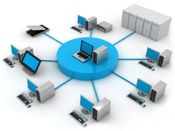Building a Better Tomorrow by Providing Mission Critical Security,
Communications and Networking Solutions for your Business
Access Systems
Visitor Management
Through Visitor Management services, 3D is able to accurately, effectively, and surreptitiously track the usage of a public building or site. In many organizations, visitors entering a ‘secure’ building, facility or campus are able to gain access by simply writing their name in a visitor log book. With today’s security concerns, this outdated practice lacks security and yields data that is incomplete, often difficult to read, and always impossible to analyze. Moreover, confidential information about recent visitors is readily available to all who flip through the pages.In contrast, a visitor management system can gather increasing amounts of information and record facility usage by specific visitor and provide documentation of the visitor’s whereabouts. Because a visitor management system provides a record of building use, these systems are frequently used to complement building security and access control systems.
Computer Visitor Management Systems
Basic electronic visitor management systems use a computer network to monitor and record visitor information. More sophisticated systems add photo ID capability, database searching, automatic door access and other functions.
An electronic visitor management system elevates visitor tracking and eliminates the problems associated with unsecure guest books. Visitor ID can be checked against national and local databases, as well as in-house databases for potential security problems. Many visitor management systems feature searchable visitor information databases. Photo ID cards can be custom printed for one-time only or continuing use. Swipe cards speed the security screening process.
Visitor Management Software
Several desktop-based visitor management software applications are available. These applications typically consist of three fundamental components: visitor registration, visitor badge printing, and reporting functionality. Some applications are capable of automatically capturing visitor information directly from a visitor's driver license, passport or other government issued identification document.

A full-service technology firm, 3D Technologies (3D) is committed to the highest quality workmanship and complete customer satisfaction. Our attention to detail and best practices for infrastructure design, installation and maintenance enable us to develop world-class turnkey systems in virtually any type of environment. We have successfully partnered with companies and government agencies around the world to improve business through technology. 3D meets complex business requirements by designing and implementing industry compliant designs and supporting IT infrastructures, telephony, and structured cabling

Access Control &Security
Security access control is a vital part of any system. 3D provides cost-effective turnkey Access Control Systems designed to meet your specific requirements for enabling authority to control access to areas and resources in a given physical facility or computer-based information system. Managed Access Control can provide personnel tracking, image verification, employee information, and event documentation. These systems can also be used to enforce policies, limiting users to specifically authorized actions and data. Virtually any door can be retrofitted with a locking system specific to an end users requirements.From Traditional Access Systems to Smart Access Systems, 3D can provide Access control, Alarm Monitoring, Digital Video, Intrusion Detection, Asset Tracking, Information, Security Integration, Credential Production, and Employee and Visitor Management functionality. Individual application modules are available as standalone systems or can be deployed in any combination to deliver a single, seamlessly integrated solution.
3D can help you assess your facilities utilizing Risk Management Consulting, and assist you to determine what level of Security your facility actually requires. This process helps to enable, you the customer; to achieve an Access Control System right for your company and enable you to understand what you are buying while maintaining your budget.
Access Control services include:
- Card access
- Closed circuit camera systems
- Digital video recorders
- Network video and storage
- Intercom entry systems
Card Access
In physical security, access control refers to the practice of restricting entrance to a property, a building, or a room to authorized persons. Physical access control can be achieved by a human (a guard, bouncer, or receptionist), through mechanical means such as locks and keys, or through technological methods such as access control systems like the access control vestibule.Physical access control is a matter of who, where, and when. An access control system determines who is allowed to enter or exit, where they are allowed to exit or enter, and when they are allowed to enter or exit. Traditionally, access was restricted through keys and locks. However, mechanical locks and keys do not restrict the key holder to entry at specific times or dates or record the key used on any specific door. Additionally, keys can be easily duplicated or transferred to an unauthorized person. When a mechanical key is lost or the key holder is no longer authorized to use the protected area, the locks must be rekeyed.
Electronic access control eliminates the limitations of mechanical locks and keys through use of three types of authenticating information:
Keypads using a password or a code
Access Card such as smart card or a proximity card
Biometrics such as a fingerprint or iris recognition, verified by biometric measurement
the proper authenticating information is presented, the electronic access control system grants access; doors will unlock for a predetermined period, and the transaction will be recorded. When access is denied, the door will remain locked and the attempted access will be recorded. The system also monitors the door and alarm should the door be forced open or remain open too long after authorized access.
Content copyright 2021. 3DLLC.INFO. All rights reserved.
